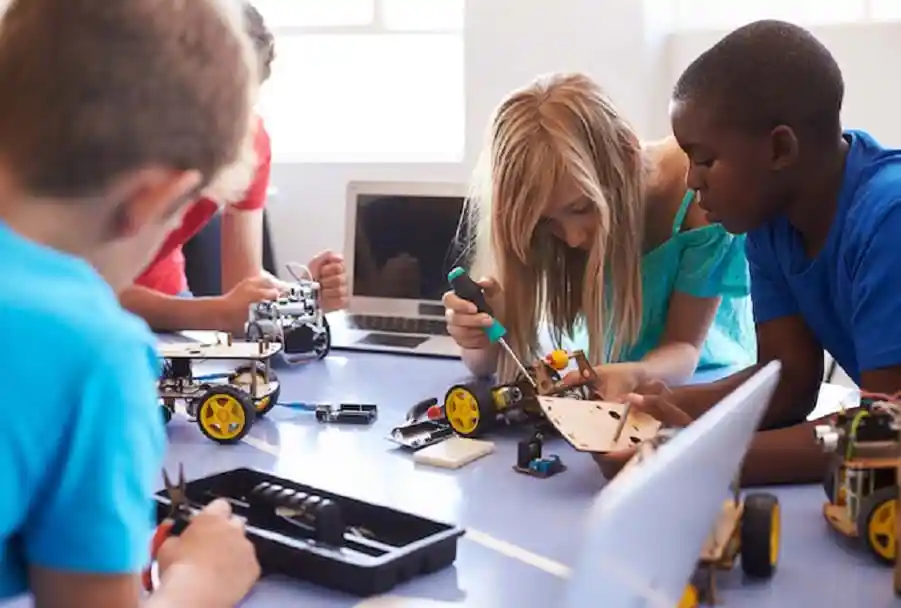In the realm of modern education, STEM education (Science, Technology, Engineering, and Mathematics) stands as a beacon of innovation and progress. It represents an interdisciplinary approach that goes beyond the confines of individual subjects, fostering a dynamic learning environment where students are empowered to explore, question, and create.
Understanding STEM Education and Its Significance
STEM Education System and Importance
STEM education is a holistic approach to learning that integrates science, technology, engineering, and mathematics into a cohesive curriculum. Its importance lies in the cultivation of essential skills like critical thinking, problem-solving, and creativity. By blending these disciplines, students are equipped with the tools needed to tackle real-world challenges and excel in a rapidly evolving technological landscape.
Exploring STEM Degrees and Activities
STEM Degrees
A STEM degree refers to a field of study focusing on science, technology, engineering, or mathematics. It encompasses a wide array of disciplines, including computer science, biology, physics, engineering, mathematics, and more. These degrees prepare individuals for careers that require analytical thinking, innovation, and technical expertise.
STEM Activities
STEM activities encompass a diverse range of hands-on projects, experiments, and challenges aimed at engaging students in STEM subjects. These activities can vary from coding workshops and robotics competitions to scientific experiments and engineering design challenges. They play a pivotal role in reinforcing theoretical knowledge by providing practical applications and fostering a passion for STEM fields.
Examples of STEM Education in Action
Real-world Success Stories
STEM education has catalyzed remarkable innovations, leading to transformative advancements. For instance:
- NASA’s Mars Rover Missions: STEM-driven initiatives at NASA have propelled groundbreaking explorations, including the Mars Rover missions. These missions, developed through collaborative efforts of scientists, engineers, and mathematicians, showcase the pinnacle of STEM’s impact, unraveling mysteries of the Martian surface and expanding our understanding of extraterrestrial environments.
- Medical Breakthroughs through Biotechnology: STEM-focused research in biotechnology has led to revolutionary medical breakthroughs. Developments in gene editing technologies like CRISPR-Cas9 have opened avenues for targeted treatments of genetic diseases, offering hope for previously incurable conditions.
- Renewable Energy Innovations: STEM-driven initiatives have fueled advancements in renewable energy. Projects like the Solar Impulse, a solar-powered aircraft circumnavigating the globe, demonstrate the potential of sustainable technology and inspire future generations to harness clean energy solutions.
- AI for Healthcare and Diagnosis: STEM-based applications of Artificial Intelligence (AI) have revolutionized healthcare. AI-driven diagnostic tools analyze vast amounts of medical data, enabling early disease detection and personalized treatment plans, enhancing patient care globally.
Technological Advancements and STEM Education
Adapting to Rapid Technological Evolution
STEM education is vital amid rapid tech changes. Integrating AI, machine learning, quantum computing, and biotech into STEM programs is crucial. This equips students to embrace new tech and drive future innovations.
The link between tech progress and STEM empowers students to adapt, fostering proactive problem-solving. It encourages interdisciplinary learning, preparing them to navigate and contribute to tech-driven industries.
Would you like more examples or further elaboration on any specific aspect?
Careers in STEM Education
STEM Education Jobs
The realm of STEM education extends beyond the classroom. It paves the way for diverse career opportunities in fields such as engineering, computer science, healthcare, environmental science, data analysis, and more. Professionals in STEM fields drive innovation, develop groundbreaking technologies, and contribute to solving some of society’s most pressing challenges.
Absolutely, considering the evolving landscape of education and technology, here’s an addition discussing the potential future trends in STEM education:
Future Trends in STEM Education
Emergence of Immersive Technologies
STEM education is poised to undergo a transformation with the integration of immersive technologies like Virtual Reality (VR) and Augmented Reality (AR). These technologies offer unparalleled opportunities to revolutionize the learning experience:
Virtual Laboratories and Simulations:
VR and AR offer immersive labs for experiments and scientific exploration. Students engage in hands-on learning beyond classroom boundaries, exploring complex concepts safely and interactively.
Interactive Learning Modules:
AR-enhanced textbooks and educational materials create interactive and dynamic learning modules. Students can visualize complex mathematical equations, intricate biological structures, or historical events through interactive 3D models, fostering deeper comprehension and engagement.
Remote Collaboration and Access:
With VR and AR, geographical barriers dissolve, enabling remote collaboration among students and educators worldwide. This facilitates knowledge-sharing, cross-cultural exchanges, and access to experts, thereby enriching the learning experience and promoting global collaboration in STEM fields.
Career Skill Development:
Immersive technologies offer avenues for skill development crucial for future STEM careers. Training in VR/AR programming, 3D modeling, and simulation design prepares students for roles in emerging industries like VR-based therapy, AR-assisted manufacturing, and immersive entertainment.
As these technologies become more accessible and refined, their integration into STEM education holds the promise of transforming traditional teaching methods, fostering innovation, and preparing students to thrive in a technology-driven society.
Addressing Challenges and the Future
Efforts for inclusive STEM pave the path for an innovative future. Integrating emerging fields prepares students for evolving job markets, making STEM the foundation for nurturing future innovators and problem-solvers.
Explore the intersection of emerging fields in STEM, including AI, machine learning, and more, building upon the insights from ‘Understanding the Field of Study in Artificial Intelligence’ article.

